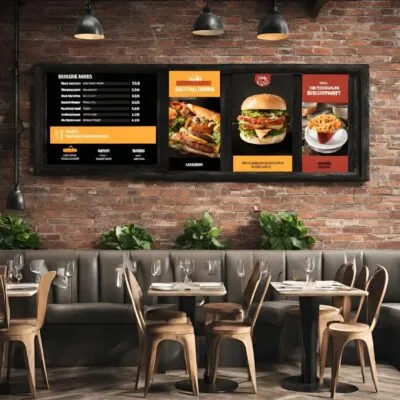A QSR, also known as a fast food restaurant, is a retail business that offers cheap meals with quick preparation and limited table services. Customers at QSRs need fast order processing to enable fast delivery of meals. The benefits of using digital menu boards are realised in this setting by a fast-ordering process, short queues, and improved profitability in the QSR industry. New figures have revealed that 80% of the customers have walked into a store because a sign attracted their attention and that digital signage results in an overall sales uplift of 31.8%. Keep reading to learn more about the benefits of digital signage and how they can be used in your enterprise.
Benefits of Utilizing Premium Digital Menu Boards for Restaurants:
As is well understood, customers start their decision-making process with menu cards. Signage, whether in paper or electronic form, is a valuable addition to any business and is a must-have. If done properly, digital signage is an inexpensive way to decrease customer waiting time, increase store traffic, and much more. Here are the key advantages of digital menu boards, accompanied by interesting facts:
Lessen Perceived Wait Times:
The second stage that customers go through is waiting, where time appears to be very long after placing their orders. Exciting animation and consistent motion on the digital signage grab customers’ attention and help to reduce perceived wait time so that customers feel happy when they receive their orders at last.
Moving the lines quickly:
Customers’ interactions are often with the quick service restaurants that use static menu signs. As visuals are processed 60,000 times faster than text (as mentioned by 3M), digital menu boards display menus with an organized format and attractive pictures, enabling customers to make the right choices promptly and speeding up the process.
Improve Customer Experience:
The efforts made in identifying and acquiring required goods directly impact diner satisfaction in restaurants, supermarkets, and other food service and shopping environments. According to the convenience sample survey analysis, the majority of restaurant patrons (74%) value an easy-to-read menu as the most important factor that would influence their dining experience positively. Of all displays, videos, and animations are the ones that add the liveliness to restaurant menus, making it an ideal option for boosting the ordering process.
Improve customers’ buying decisions:
Specifically, 29% of customers are affected by digital menus when making their choice of products to purchase. The use of electronics instead of printed signs allows to attract people’s attention within seconds and showcase the menu items with visuals, videos, and animations. Offering customers some products on sale and the most popular items will make them buy them.
Simply Update Prices and Digital Menu Board Items:
Nento’s digital menu boards help businesses to easily update menu items and prices from anywhere and anytime using technology due to the supply and demand in the market, promotional campaigns, and events. Also, they have the feature for sending updates to all or only some of the restaurants chosen. This ability to set prices for products and consciously push products with high demand enhances the sales and consequently the revenue.
Animation With Great Resolution And Dazzling Colors:
Nielsen Norman Group was able to establish that animation grabs attention, at the very least, in the peripheral vision of customers. Digital signage is characterized by having particular styles, special effects, colors, and high definition to make menu items, photos, or videos attractive.
Respond Quickly and Manage Easily
In the given dynamic business environment, there is a need for QSRs to possess the characteristics of flexibility. Digital menu content acts as a tool of creating awareness of products to customers and is flexible when it comes to changing product offers, including promotional products.
Encourage Upselling by Digital Menu Boards:
POS digital signage has the prospect of giving the consumer an offer of additional products depending on the inputs in the POS system. This applies more so to restaurants that deal with combos and additions that accompany meals, such as side orders, beverages, and desserts.
Sponsor at the Right Time:
Digital menus facilitate the delivery of various marketing messages at the right time, as they are used in compiling menus. This is actual because the use of the scheduled publishing helps to plan future promotions and deliver important messages to the customers on time. Test items can be advertised without necessarily having to develop new posters and signs, which would be costly to the restaurant.
No Printing Costs with Digital Menu Boards:
Static menu boards, on the other hand, are printed and installed, hence involving costs in printing and installation, but with digital signage, these costs are cut out, thus being environmentally friendly.
Automate Menu Variations:
Digital signage enables QSRs to have different menus at different times of the day and different days of the week. The Dayparting feature is designed to change over between the breakfast, lunch, and dinner menus automatically.
Uphold brand reliability with digital menu boards:
It is important that the marketing process show a specific brand image. Digital menu boards are useful in ensuring that the same menus are implemented in all places to reduce the variation of the same. This makes it easy to manage and scale while creating credibility and giving customers a lasting memory.
Conclusion:
The use of technology in the restaurant has been widely embraced, with the use of digital displays being a major boost to the industry. This has made structures like posters and notice boards outdated, making way for things like digital signage. Restaurants that use technology can satisfy the various needs of the consumer by visually linking the consumer with the business. And in this context, the possibilities of digital menu boards are endless, which are regulated only by the availability of ideas.





